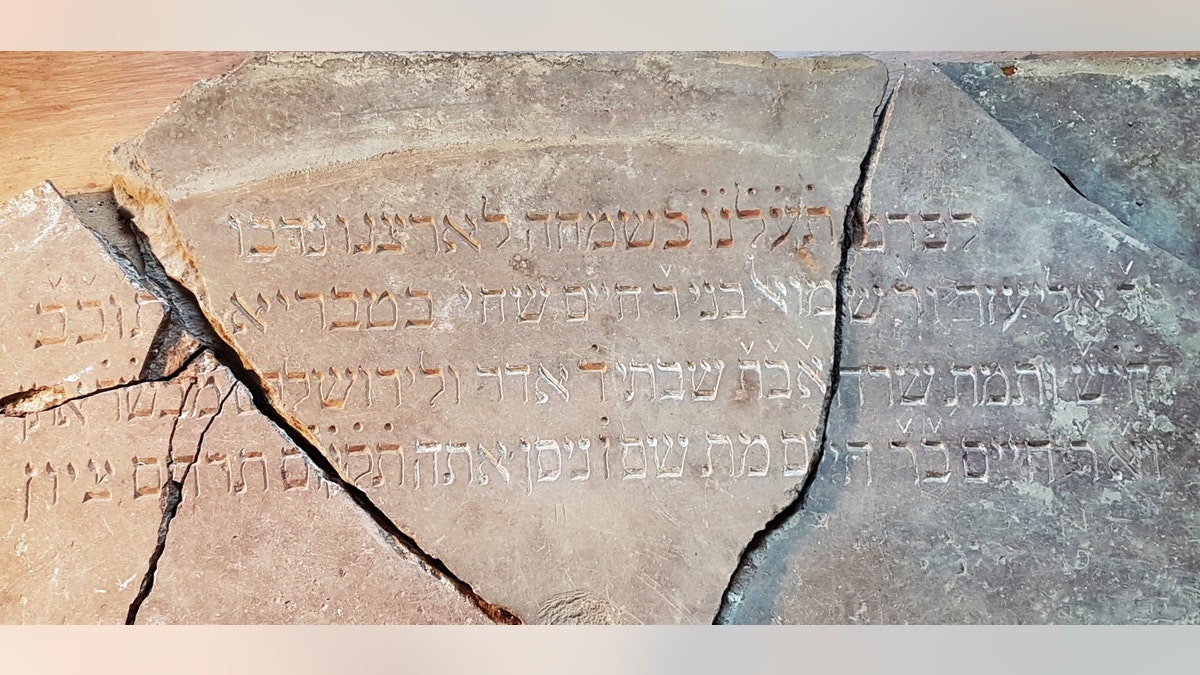Fox News Flash top headlines for July 23
Fox News Flash top headlines for July 23 are here. Check out what's clicking on Foxnews.com
Archaeologists have uncovered 200-year-old Hebrew inscriptions at the site of the Great Synagogue of Vilna (Vilnius) in Lithuania for the first time since its destruction during the Holocaust.
Constructed in the 17th century, the impressive Renaissance-Baroque-style Great Synagogue was razed during the Nazi occupation of Lithuania.
Lithuanian and Israeli researchers have found an inscription, dated to 1796, that was part of a stone Torah reading table in the synagogue. The table was used to read the Torah to the synagogue’s congregation until the building’s burning and final destruction by the Soviets 70 years ago.
RADAR TECHNOLOGY HELPS REDISCOVER THE GREAT SYNAGOGUE OF VILNIUS, 70 YEARS AFTER ITS DESTRUCTION
The inscriptions explain that the table was donated by brothers Rabbi Eliezer and Rabbi Shmuel in memory of their mother, Sarah, and father, Rabbi Chaim, who had emigrated to Israel. Passages from the Bible were also uncovered.

The excavation of the Great Synagogue of Vilnius. (Jon Seligman, Israel Antiquities Authority)
Additionally, a seating plaque for the head of the organization that managed the synagogue was found as well as large sections of the synagogue’s once magnificent Bimah. The Bimah, a platform from where the Torah is read, was once an ornate two-story structure within the synagogue. Other recent discoveries include hundreds of coins from the 16th to 20th centuries and buttons from Napoleon’s Army, which passed through Vilnius during its ill-fated invasion of Russia in 1812.
Experts from the Israel Antiquities Authority and Lithuanian conservation officials have been excavating the site every summer for the last four years. “The project of exposing the historic Great Synagogue of Vilna is part of the IAA's 'Heritage without Borders' concept, which also includes the research of sites outside the borders of the State of Israel,” said IAA director Israel Hasson, in a statement. “This arises from the perception that the IAA was entrusted by the Israeli public to serve as the 'watchtower' on its behalf for the protection of heritage and cultural assets."
HOLOCAUST DISCOVERY: RITUAL BATHS UNCOVERED IN SYNAGOGUE COMPLEX DESTROYED BY NAZIS
Dr. Vladimir Levin of the Hebrew University of Jerusalem also studied the inscription.

The inscription was once part of a stone Torah reading table. (Jon Seligman, Israel Antiquities Authority)
The synagogue was at the heart of the Jewish community in Vilnius for hundreds of years until its destruction by the Nazis. Prior to the Holocaust, the Great Synagogue was also surrounded by a host of buildings, including other synagogues, a community council, kosher meat stalls, miqva’ot (ritual baths) and the famous Strashun rabbinical library.
The site was also home to Rabbi Eliyahu, the celebrated 18th-century Vilna Gaon, or “genius.”
HOLOCAUST ESCAPE TUNNEL FOUND: PRISONERS DUG WITH SPOONS TO ESCAPE NAZIS
The Great Synagogue compound was looted and burned by German forces in 1941, and the standing remains were later completely destroyed by Soviet authorities in the 1950s. The Soviets later built a school on top of the area in 1964.
In 2015, archaeologists used ground-penetrating radar to locate the remains of the Great Synagogue and the buildings around its ‘Shulhoyf’ or ‘shulof’ community courtyard. In 2017 researchers uncovered two ritual baths in the remains of the synagogue.
CLICK HERE TO GET THE FOX NEWS APP
In a separate project in Lithuania, a tunnel used by Jewish prisoners to escape the Nazis was discovered.
Follow James Rogers on Twitter @jamesjrogers

